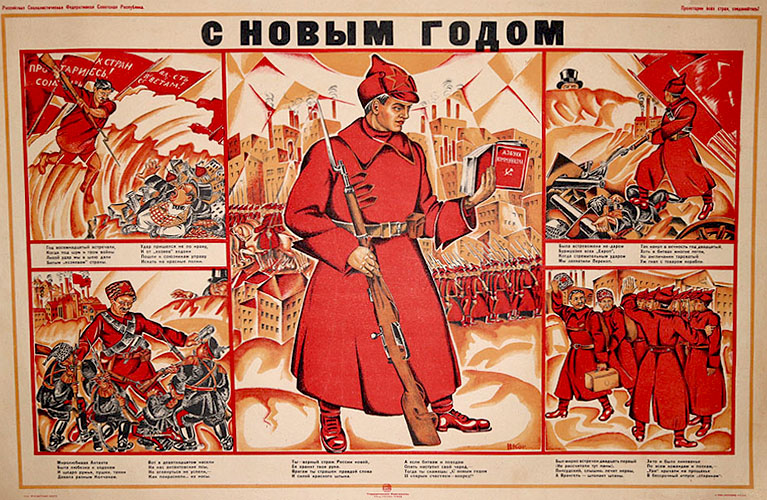
Happy New Year
Poster Number: PP 1202
Category: Civil War
Poster Notes: Soldier at middle is holding the book "The ABC of Communism" written in 1919 by Nikolai Bukharin (1888-1938), General Secretary of the Communist International, and Evgenii Preobrazhenskii (1886-1937), a member of the Central Committee. Both authors were arrested, tried and executed in the Stalinist Purges; the poster was likely published late 1922 for the 1923 New Year; [Top left] Russian Socialist Federated Soviet Republic; [Top right] Workers of all Countries, Unite!
Media Size: 44x30
Poster Type: Lithograph
Publishing Date: c. 1922
Technical Information on Poster: Publication No. 2596; RVTs (Passed by Military Censor) No.999, Moscow
Print Run: 25,000
Sources & Citation: Soviet Posters of the era of the Civil War 1918-1921 by B. S. Butnik-Siverskii (1960), page 310, poster 1668
Catalog Notes: PP 1202 Civil War c
Artist: Kogout, Nikolai Nikolaevich — Когоут, Николай Николаевич
Nikolai Nikolaevich Kogout was one of the preeminent artists of the poster genre during Russia's early revolutionary period. In 1913, Kogout graduated from the Stroganov Central School of Industrial Art in Moscow and subsequently attended VKhUTEMAS [Higher Art and Technical Studios]. He contributed works to the seventh exhibition of the art group L'Araignée and exhibited at Galerie Devambe in Paris in 1925. During the Russian Civil War, Kogout designed posters from 1918 to 1920 for Revvoensovet, the propaganda d...
Read More About This Artist
Printer: MSNKh 5th Typolithography, Moscow — МСНХ 5-я типо-литография, Москва
The MSNKh (Moscow Council of National Economy) 5th Typography Workshop was located in Moscow. Little information is available on the history of the printer. While the 5th Typolithography served as a contract printer for the MSNKh as early as 1920; documentation from 1922 indicates the workshop was operating under Mospoligraf, one of the largest government-owned printing trusts in Moscow.
Read More About This Printer
Publisher: State Publishing House — Государственный издательство
The State Publishing House had its origins in Imperial Russia as the Royal Print Yard of St. Petersburg. In 1917, the Soviets nationalized the print yard and requisitioned its presses. From requisitioning emerged the Publishing House of the Petrograd Soviet that was formed in the winter of 1917 by the Literary and Publishing Department of People's Commissariat for Education. In 1919, the State Publishing House in St. Petersburg changed its name to Petrogosizdat (Petrograd State Publishing) and in 1924, ...
Read More About This Publisher